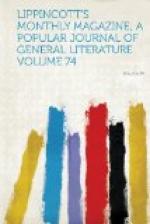The boat was hauled on the wind, the mast unshipped, and, harpoon in hand, Captain Sol stood braced for the affray. The ripple seemed alive with the ghostly creatures, their white forms darting here and there, while the puffing came fast and furious.
“Stand by to git aft!” whispered the harpooner, and that moment, instead of a white head, the entire body of a Beluga rose in front of the boat, clearing the water in a graceful leap.
Quick as thought the skipper hurled his weapon. It struck with a sounding thud, a wing shot, and the great creature fell heavily, impaled in mid-air, to rush away, bearing boat and white-whalers far down the river toward the sea.
C.F. HOLDER.
* * * * *
OUR MONTHLY GOSSIP.
A Virginia Lady of the Old School.
Among the many beautiful and fascinating women who adorned Richmond society at the beginning of the present century there were few more remarkable and interesting than Mrs. Mayo, the wife of Colonel John Mayo, founder of the bridge at Richmond that bears his name. She was the daughter of John De Hart, of New Jersey, an eminent lawyer and a member of the first Continental Congress. Bellville, the home of Colonel and Mrs. Mayo, in the suburbs of Richmond, was the seat of elegant and boundless hospitality. No person of distinction ever came to Richmond without calling at Bellville, the entree to which was an unquestioned passport to the best society of the city.
Mrs. Mayo’s eldest daughter, Maria, was the most celebrated Virginia belle of her day. She never gave a decided answer to any of her numerous suitors, and the story goes that one evening three gentlemen met at her house, and after a very pleasant visit they returned to Richmond together. One of them asked the others why they went there, as he was engaged to Miss Mayo and expected shortly to marry her. The other gentlemen also said they had hopes of winning the fair lady. The first gentleman determined to have the matter settled, and accordingly went to her house the following day and sought an interview with Mrs. Mayo. He told her he had her daughter’s consent, and asked hers. Mrs. Mayo replied she was sorry she could not give her consent, and the gentleman then understood that the mother and daughter were in perfect accord in the matter of the young lady’s love-affairs. In this way Miss Mayo kept on hand a regiment of admirers, who formed a sort of reserve-corps. When John Howard Payne, the author of “Home, Sweet Home,” visited Richmond, he was a frequent guest at the Mayo mansion. He wrote a poem, in which he described himself as falling asleep in a grove and all the months of the year appearing to him. The month of June was the first, and he finally winds up with May, which he described in very glowing language, ending with the line,—
Sweet May, oh, I could love thee ever.




